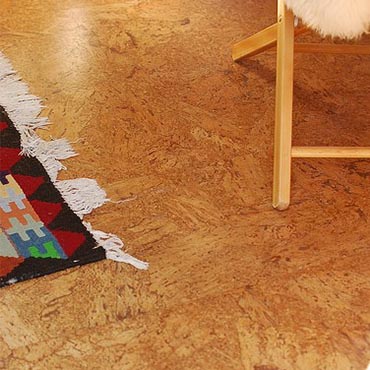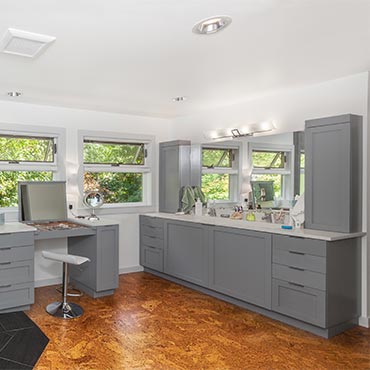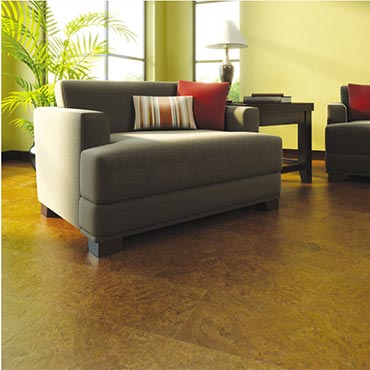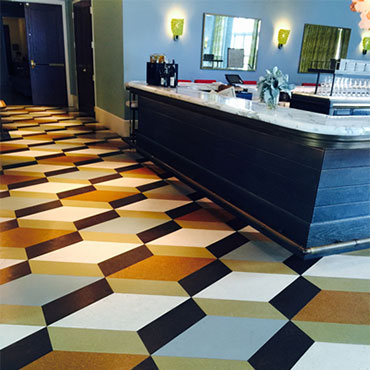Representing the fifth generation in the cork industry, WE Cork offers the highest level of experience and quality in natural cork flooring, sound control under hardsurface flooring, crack isolation under tile, expansion joints, bulletin board cork, anti-vibration cork, insulation cork, Decoy block cork, and wall covering. Learn More
Cork Flooring
Cork Flooring Guide

Cork Flooring: A Sustainable and Stylish Choice for Modern Architecture
In the realm of modern architecture and interior design, cork flooring stands as a testament to innovation, marrying aesthetics with environmental consciousness. Esteemed by architects, designers, and building contractors, cork's natural qualities and versatility make it an increasingly popular choice. This article delves into the intricacies of cork flooring, offering professionals insights into its types, characteristics, sustainable practices, and technological advancements.
Types of Cork Flooring
Cork, harvested from the bark of the cork oak tree, offers a unique blend of comfort, durability, and aesthetic appeal. Here's a closer look at the most popular types of cork flooring:
- Natural Cork Flooring: Celebrated for its rich, warm tones and distinctive grain patterns, natural cork brings an organic feel to interiors. Its softness underfoot makes it ideal for residential spaces and areas where comfort is paramount.
- Engineered Cork Flooring: This type consists of a top layer of cork bonded to a stable core material, often HDF or plywood. Engineered cork is lauded for its enhanced stability and suitability for environments with fluctuating temperatures and humidity, like kitchens or basements.
- Colored and Patterned Cork: For spaces requiring a more dynamic or contemporary look, colored and patterned cork tiles offer designers a broader palette. From bold hues to intricate designs, these options can complement various architectural styles, from minimalist to eclectic.
- Cork Plank Flooring: Resembling hardwood planks, cork plank flooring brings a classic look with a twist. It's perfect for commercial spaces or homes aiming for a traditional aesthetic with an eco-friendly edge.
Each type of cork flooring presents unique characteristics in grain patterns, color variations, and hardness, making it crucial to match the right type with the intended architectural style and design theme.
Installation, Durability, and Environmental Suitability
Cork flooring's ease of installation is a boon, especially the click-and-lock planks and tiles that make DIY projects feasible. However, professionals should consider the specific demands of each environment. For instance, while cork is naturally resistant to mold and mildew, areas with high moisture levels may require additional sealing.
In terms of durability, cork's natural resilience and ability to bounce back from compressions make it suitable for high-traffic areas, though it can be susceptible to scratches and dents. Regular maintenance and the use of protective finishes can enhance its longevity.
Sustainable Practices in Cork Flooring
Sustainability is a cornerstone of cork flooring's appeal. The cork oak tree regenerates its bark, making cork harvesting a model of renewable resource utilization. Additionally, many manufacturers are committed to eco-friendly practices, including the use of low-VOC adhesives and finishes, further solidifying cork's status as a green material choice.
Technological Advances
Recent years have seen significant technological strides in cork flooring. Advances in finishing techniques have resulted in more durable, scratch-resistant surfaces. Improved installation methods, like advanced adhesive systems and click-lock technology, have simplified the process, making cork flooring more accessible and appealing to a broader range of projects.
Conclusion
Cork flooring, with its unique blend of aesthetic versatility, comfort, and sustainability, offers architects, designers, and contractors a material that does not just meet the functional requirements of a space but enhances its overall appeal. Its adaptability to various design themes, from rustic to modern, coupled with its eco-friendly nature, makes it an intelligent choice for a wide range of projects. By selecting the appropriate type of cork flooring and leveraging recent technological advancements, professionals can create spaces that are not only visually striking but also environmentally responsible and enduring.
Incorporating cork flooring into a project isn't just a matter of selecting a sustainable material; it's about making a statement on the importance of marrying design with environmental stewardship. Whether it's a cozy residential setting, a bustling commercial space, or an avant-garde architectural masterpiece, cork flooring stands as a testament to innovative, conscious design.
Disclaimer: The information provided in this article is for general informational purposes only. While we strive to ensure the accuracy and reliability of the information presented, we make no warranties, express or implied, about the completeness, accuracy, reliability, suitability, or availability with respect to the content. Any reliance you place on such information is strictly at your own risk. We recommend consulting with professionals for specific advice tailored to your project’s needs, particularly regarding building codes, regulations, and product specifications.
Under no circumstances shall we be liable for any loss or damage, including without limitation, indirect or consequential loss or damage, arising from the use of, or reliance on, the information provided in this article.
Select Product Sub-Category:
Cork Flooring
Top 3 Types of Cork Flooring
 Wood Flooring - 170 Cork Tile FlooringTransform your space with Cork Tile Flooring! Experience eco-friendly, durable, and stylish flooring that's perfect for any room. Upgrade your home today with the natural beauty of cork. Order now! | |
 Wood Flooring - 625 Cork Plank Flooring
Introducing Cork Plank Flooring: A natural and eco-friendly choice for your space. Enjoy comfort, durability, and style with every step. Transform your home today! | |
 Wood Flooring - 171 Cork Sheet FlooringIntroducing Cork Sheet Flooring: A natural, eco-friendly choice for your space. Discover warmth, comfort, and durability in every step. Elevate your flooring experience today. |
Featured Brands
The Best 4 Cork Flooring Brands

WECork Flooring
Profile | Website | Video | What's New | Warranty | Install | Maintain | GreenRepresenting the fifth generation in the cork industry, WE Cork offers the highest level of experience and quality in natural cork flooring, sound control under hardsurface flooring, crack isolation under tile, expansion joints, bulletin board cork, anti-vibration cork, insulation cork, Decoy block cork, and wall covering. Learn More

APC Cork Flooring
Profile | Website | Design Tools | Warranty | Install | Maintain | FAQs | GreenOur goal at APC Cork is to be a professional, eco-conscience supplier of cork floating floors and cork tiles to the public and educate them on the benefits of using it in their home. At the foundation of this goal is our dedication to quality craftsmanship and attention to every detail, ensuring a high level of customer satisfaction. Learn More

Amorim Cork Flooring
Profile | Website | What's New | GreenAmorim Flooring develops distinctive, elegant, resistant and comfortable products, using a material whose qualities science has not yet been able to surpass - and which has proven environmental benefits - cork. Learn More

Globus Cork Flooring
Profile | Website | Install | FAQsGlobus Cork offers a vast range of patterns and sizes not found from any other cork manufacturer. The result is nearly endless design choices for our customers and as a harvested product, the environmentally sound choice for flooring. Learn More
Cork Flooring Videos
The Top 7 Cork Flooring Videos
Why Cork Flooring? | Candice Olson
Installing Cork Floors
Cork Flooring Reviews
Cork Flooring News
Latest Cork Flooring News
Cork Tile Flooring...iors, discussing its types, durability, and how it enhances spaces, with insights for professionals in selecting the ideal type for various projects. Types of Cork Tile FlooringCork flooring comes in two primary forms: cork tiles and floating cork planks. Cork tiles, typically glued down, offer a traditional look and are ideal for custom designs and patterns. Floating cork p... |
Cork Sheet Flooring... we will explore the significance of cork sheet flooring in modern interior design, discussing its types, features, benefits, and the latest trends. Types of Cork Sheet FlooringCork flooring comes in a variety of types, each offering unique qualities. The traditional cork tiles are known for their classic look, while floating cork floors offer a modern twist, ideal for quick... |
Cork Plank Flooring...of VarietyCork Plank Flooring is not a one-size-fits-all solution; it offers a diverse array of types and species, each bringing a unique flair to interior spaces. The most common types of Cork Flooring include solid cork tiles, cork floating floors, and cork rolls. Each type serves different design needs, from solid cork tiles offering a traditional appeal to cork floating floors that ... |
Cork Flooring...Cork Flooring: The Sustainable Choice for Innovative Interior Design In the evolving world of interior design, cork flooring stands out as an eco-friendly, versatile, and aesthetically pleasing option. With its unique characteristics, it's increasingly becoming a popular choice for designers, decorators, and consultants who seek to combine sustainability with style. This articl... |



